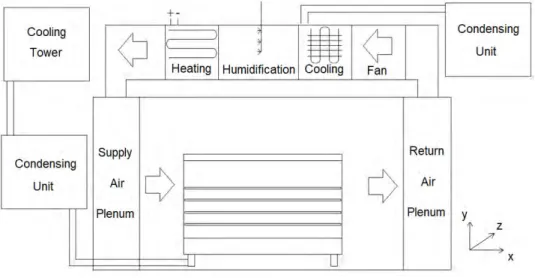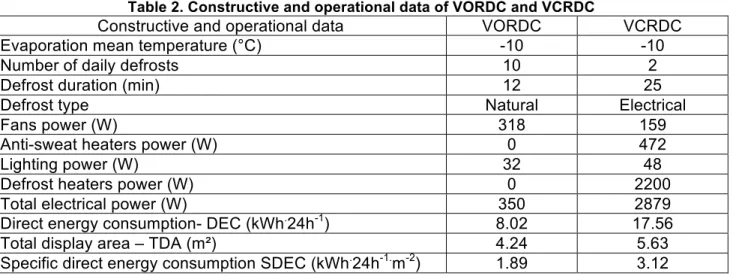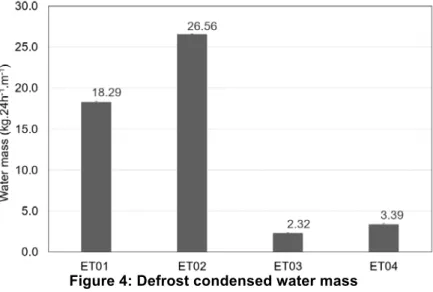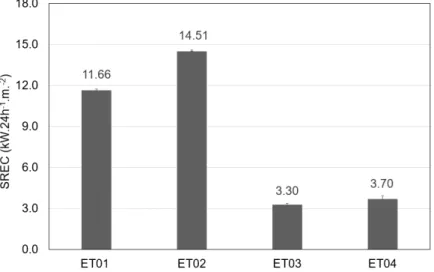Manuscript ID: 1296 DOI 10.18462/iir.icr.2019.1296
Comparing open and closed vertical refrigerated display
cabinets at mild and tropical external environments
Gustavo G. HEIDINGER
(a,b), Samuel M. NASCIMENTO
(a,b), Pedro D.
GASPAR
(b,c), Pedro D. SILVA
(b,c)(a) Eletrofrio Refrigeração Ltda, rua João Chede 1599, 81170-220, Curitiba - PR, Brazil e-mail: gustavo@eletrofrio.com.br, web: http://www.eletrofrio.com.br
(b) University of Beira Interior, rua Marquês d’Ávila e Bolama, 6201-001, Covilhã, Portugal (c) C-MAST - Centre for Mechanical and Aerospace Science and Technologies, Covilhã, Portugal
e-mail: dinis@ubi.pt, dinho@ubi.pt, web: http://www.ubi.pt
ABSTRACT
This paper reports the results of experimental tests performed according to ISO 23953 in vertical open and closed refrigerated display cabinets (VORDC vs. VCRDC). Tests were performed at a mild climate class (n. º 3: T=25°C; φ=60%) and a tropical one (n. º 6: T=27°C; φ=70%). The direct energy consumption is 46% higher at VCRDC due to the heated glass doors frame and defrost heaters. The product simulator temperature is higher and more stable at VORDC. The highest product simulator temperature is lower (-1.4°C) at the VCRDC and less stable (+2.7°C variation) due to the opening doors period. The total mass of condensed water at the evaporator is reduced 87% and the total heat load is 77% lower at the VCRDC. Thus, the estimated total energy consumption is reduced 42%. Given the current concerns with energy consumption and sustainability of the heat exchange processes, the VCRDC provide the best solution.
Keywords: Air Curtain, Climatic Chamber, Closed Cabinet, Experimentation, Open Cabinet.
1. INTRODUCTION
In general, refrigerated displays cases are designed and certified to operate in supermarkets that have ambient air conditioning, the European industry considers the mild climatic condition of dry bulb temperature and humidity of Ta = 25°C and φa = 60% (climate class n.°3 - ISO 2395, 2015) as standard for approval pattern of this type of equipment (critical summer condition). In practice, there are stores located at semi-tropical or tropical climate regions without ambient air conditioning, therefore, more adverse conditions of air temperature and humidity are regularly found. To meet this demand, the ambient air condition of Ta = 27°C and φa = 70% (climate class n.° 6 - ISO 23953, 2015) was defined as the climatic class of tropical climates for conducting the experimental tests. Refrigerated display cases are usually classified on vertical, semi-vertical, horizontal and combined; which can be closed or opened to the store environment; for self-service or not. Open refrigerated displays cases are those whose products access occurs without the need to open doors or lids and closed refrigerated displays cases are the opposite (ISO 23953, 2015). Vertical open refrigerated displays cases (VORDC) are the most susceptible classification to problems due to ambient temperature oscillation and local air humidity. Since the external air infiltration is the most relevant aspect of the refrigeration load which is between 67 and 81% (Faramarzi, 1999, Gaspar et al., 2011 and Chieffo et al., 2018), therefore, the surrounding ambient influence on the performance and energy consumption of this type of equipment should be analyzed carefully in order to minimize the thermal exchange between the external (environmental) and internal (refrigerated space) air, therefore, optimize the overall operation of the VORDC (Gaspar et al., 2010, Chen et al., 2011, Cao et al., 2011, Laguerre et al., 2012, Nascimento et al., 2015 and Nascimento et al., 2016). Nowadays the VORDC are being replaced or retrofitted by the vertical closed refrigerated display case (VCRDC), i.e., with glass doors to reduce the energy consumption. Orlandi et al. (2013) quantify by computational fluid dynamics simulations the
VCRDC heat load components. Evans (2014) compiled a series of studies related to the installation and/or retrofit using VCRDC that can reduce the refrigeration load by 25 to 86%. The insertion of a physical barrier between the consumer and the exposed products is the main negative impact provided by the door glass that may reduce the product sales. Nevertheless, Frickie and Becker (2010) concluded that the installation of VCRDC do not have effect on product sales, but may improve the food safety and eliminate the cold aisle effect.
Comparing the VORDC and the VCRDC performance based on experimental results, the present work aims to assists the refrigerated display cases design and operation mainly in countries that have a high thermal amplitude from region to region and in stores that do not have equipment to control the temperature and the humidity of the ambient air. The results of experimental tests, performed according to ISO 23953 in VORDC and VCRDC at climate classes n.º 3 (Ta = 25°C; φa = 60%) and n.º 6 (Ta = 27°C; φa = 70%), evaluate the influence of double glass doors in the direct energy consumption, product simulator temperature, evaporator total condensed water mass, total heat load and total energy consumption.
2. EXPERIMENTAL PROCEDURE
Experimental tests were conducted in an environmental test chamber constructed according to ISO 23953 (2015) shown in Fig. 1. There is an air treatment to keep the air temperature and humidity surrounding the display cases at the climatic class n.° 3 (Ta = 25°C; φa = 60%) or at the climatic class n.°6 (Ta = 27°C; φa = 70%). The air treatment steps are cooling, heating and humidification, which are carried out respectively by an evaporating coil, heating devices and water vapor mixed to the airflow on the ducts. The test room is a thermally insulated parallelepiped shaped space in which two of the opposing sidewalls are designed to provide a uniform horizontal airflow (va = 0.1 to 0.2 m.s-1) through the room.
Figure 1: Environmental test chamber
The refrigerated display cases manufacturer recommends an evaporation temperature of -10±1 °C, when the VORDC and VCRDC are used for displaying fresh meat products, which temperature should be maintained between -1°C and +5°C (ISO 23953 class M1). The tested VORDC has 2.62m×2.12m×1.10m with a dual air curtain and 4 shelves as shown in Fig. 2a. The tested VCRDC has 3.82×2.10m×0.92m with six doors and four shelves as shown in Fig. 2b. The VORDC has 2.50 meters and the VCRDC has 3.75 meters of useful length (x). This industry field develop the display cases to be modular. In this case, the equipment lengths could be multiples of 1.25m, and the fans, lighting and heaters are proportionally disposed. Thus, the condensed water mass comparisons will be made per unit of length. One of the main functions of refrigerated cases is display as many products as possible into the smallest available display area, so the energy consumption comparisons will be based on the Total Display Area (TDA) of the equipment.
(a) (b)
Figure 2: Tested refrigerated display cases: (a) VORDC and (b) VCRDC
The VCRDC needs a special device to open doors automatically, each door must open once every ten minutes. The total duration of each door opening should be 6 seconds. Opening to an angle greater than 60° should last 1 second, 4 seconds of open door (> 60°) and 1 second for closing. The door opening test period should be 12 hours per day (ISO 23953, 2015).
Each test period lasted 24 hours and was repeated three times. The mass of water condensed during defrost was manually collected and measured in each test period. The temperature and pressure were collected on the suction and liquid lines to measure the R22 refrigerant enthalpies, and a Coriolis flowmeter was used to measure the outlet mass flow of the liquid coolant, 𝑚!, that
passed through the evaporator during each operating period. The warmest product simulator temperature is collected to classify the refrigerated display cases as function of the displayed required product temperatures.
The remote refrigeration system is composed by a cooling tower and a hydraulic pump that drives the water used to draw heat from the cooling system in the condenser. A control valve, which keeps the condensing temperature approximately constant (39±1 °C), controls the water flow. The compressor pack was maintained in the same operating condition (evaporation pressure) by an inverter and there is no controller to stop the compressor work, i.e., there is no solenoid valve or set-point control at the refrigerant liquid line, thus the display cases are at the maximum possible refrigeration capacity during all the tests period. The compressor is only turned off when the defrosting process begins.
ISO 23953 (2015) defines the equations to calculate the TDA and the energy consumption indicators: Direct daily electrical Energy Consumption, DEC (kWh.24h-1); Refrigeration daily
electrical Energy Consumption, REC (kWh.24h-1); Total daily electrical Energy Consumption, TEC (kWh.24h-1); and Specific daily electrical Energy Consumption, SEC = TEC/TDA (kWh.24h-1.m-2). The TDA is based on the display case length and on the horizontal (open – Ho and glazed - Hg) and vertical (open – Vo and glazed - Vg) projections dimensions (Fig. 2), i.e., the parameter that allows the comparison between product visualization and energy consumption, even between different types and lengths (x axis, open or glazed) of refrigerated display cases. The DEC includes the energy consumption of fans, heaters and lighting and is evaluated from its electrical power and respective operation times. The REC is calculated based on the total heat load to estimate the compressor energy consumption on a standard operational compressor condition. In its turn, the total heat load is calculated from the mass flow of the refrigerant fluid that passes across the evaporator during each operation period and the corresponding enthalpy change. The TEC is the sum of DEC and REC. In order to compare the VORDC and the VCRDC performance, as they have different lengths, the specific energy consumption indicators were used based on the total display area.
Table 1 shows the experimental tests (ET) conditions. The comparisons between experiments are based on the electrical nominal data, warmest product simulator temperature, total mass of
condensed water on the evaporator fins, total heat load and energy consumption (direct, refrigeration, total).
Table 1. Experimental tests
ET Display case Climate class
01 VORDC 3 (25°C/60%)
02 VORDC 6 (27°C/70%)
03 VCRDC 3 (25°C/60%)
04 VCRDC 6 (27°C/70%)
3. ANALYSIS AND DISCUSSION OF RESULTS
3.1 Operational and Direct Energy Consumption Data
The constructive and operational differences between the VORDC and VCRDC are presented in Table 2.
Table 2. Constructive and operational data of VORDC and VCRDC
Constructive and operational data VORDC VCRDC
Evaporation mean temperature (°C) -10 -10
Number of daily defrosts 10 2
Defrost duration (min) 12 25
Defrost type Natural Electrical
Fans power (W) 318 159
Anti-sweat heaters power (W) 0 472
Lighting power (W) 32 48
Defrost heaters power (W) 0 2200
Total electrical power (W) 350 2879
Direct energy consumption- DEC (kWh.24h-1) 8.02 17.56
Total display area – TDA (m²) 4.24 5.63
Specific direct energy consumption SDEC (kWh.24h-1.m-2) 1.89 3.12
The number of daily defrosts has been reduced from 10 to 2, because the doors are a much more efficient barrier than just the air curtain to the external air infiltration, which also explains the reduction in fans power. The LED lighting used in the tests was proportional based on the display case length. The refrigerated display cases are designed to operate in tropical climates, so there are anti-sweat heaters to prevent the water condensation on the frames of the double glass doors. During night and closed-door defrost periods, there is less ambient air infiltration and, consequently, a difficulty defrost without heating the air, so defrost heaters are used in the VCRDC evaporators. Thus, the total installed electrical power of the VCRDC is 8 times higher than the electrical power installed in the VORDC. However, it must be pointed out that defrost heaters are turned on only for 50 minutes per day.
3.2 Product Simulator Temperature
The VORDC show higher and more uniform product storage temperature values because the infiltration of external air into the refrigerated space is constant throughout the operation period under the test conditions. The VCRDC test show lower temperature values of the product simulators and with considerably variation due to the periods with and without door opening (Fig. 3). During the door opening period, product temperatures range up to 2.7°C due to the external air infiltration into the refrigerated space. The warmest product simulator is the most representative temperature to classify the refrigerated display cases as function of the displayed required product temperatures. Thus, comparing the ETs in climatic class n.° 3 (ET01 and ET03), the maximum temperature of the warmest product simulator is 1.4°C lower in VCRDC tests. In the
climatic class n.° 6 experimental tests (ET02 and ET04), the maximum temperature of the warmest product simulator is 1.0°C lower in the VCRDC tests. Thus, the two displays meet the standard temperatures (class M1, from -1.0°C to +5.0°C), but the VCRDC presents lower product conservation temperatures.
Figure 3: Warmest product simulator temperatures 3.3 Condensed defrost water
As much for VORDC as for VCRDC, when the climactic class changes from n.° 3 to n.° 6 (ET01
vs. ET02; ET03 vs. ET04) occurs an increase of approximately 46 % in the evaporator condensed
water mass. However, the absolute quantity is quite different as shown by the same environmental condition tests (ET01 vs. ET03; ET02 vs. ET04), the water and ice formation in the VCRDC evaporator is reduced by 87% (Fig. 4). Therefore, the drastic reduction in the amount of defrost water due to the doors use is fundamental to increase the efficiency of refrigerated display cases once the air infiltration is decreased. This situation also allows to reduce the stops required to defrost the evaporator, and, consequently, reduces the temperature pull-down energy consumption.
Figure 4: Defrost condensed water mass 3.4 Refrigeration Energy Consumption
The VCRDC total heat load is substantially reduced due to the increased protection provided by the doors use. The air infiltration reduction reduces mainly due to the latent heat load decrease as less moisture exists at the refrigerated space. Fig. 5 shows the SREC in each of the ETs.
The SRECVORDC increases 25% when the climatic class changes from n.° 3 to n.° 6 (ET01 vs. ET02) while the SRECVCRDC increases 12% (ET03 vs. ET04). Thus, the increase on the ambient air
enthalpy affects more intensely the VORDC than the VCRDC due to the doors that protect the refrigerated space from the warm and humid air infiltration. Comparing the ETs in climatic class n.° 3 (ET01 and ET03), the SREC of the VCRDC is 72% lower than in the VORDC. At the climatic class n.°6 (ET02 and ET04), the SREC in the VCRDC is 75% lower than in the VORDC. Therefore, the compressor energy consumption is significantly lower when the vertical refrigerated displays cases have doors and the main benefit is the impact on the heat load. The hotter and humid the environment is, the more important is the doors use because the VORDC energy consumption is very dependent on the climate conditions.
Figure 5: Specific refrigeration consumption 3.5 Total Energy Consumption
Considering the energy consumption of the fans, lighting and heaters, SDEC, added to the estimated compressor energy consumption, SREC, i.e., the total energy consumption of the refrigerated display cases per unit of display area, SEC, represents the absolute difference between the energy performance of VORDC and VCRDC. Fig. 6 shows the SEC values for the ET’s.
Figure 6: Specific total energy consumption
The operation of the defrost and anti-sweat heaters on VCRDC will cause an increment of 65% in the SEC value. When the environmental condition changes from climate class n.° 3 to the climate class n.° 6 the SECVORDC increases 21% while the SECVCRDC increases 6%. At climate class n.° 3 the VCRDC uses 52% less energy than the VORDC and in climatic class n.° 6 the reduction increases to 58%. Thus, the VCRDC needs more DEC (+65%) but the REC is reduced (up to -75%) which is much more significant to these display cases energy efficiency performance.
4. CONCLUSIONS
The significant increase in the electrical energy cost motivates and accelerates the use of more efficient refrigerated display cases. The maximum product temperatures on VCRDC are about 1.4°C lower than the VORDC, however, more temperature oscillation occurs due to the door opening period. The use of glass doors propitiates a latent heat load reduction up to 87% and a total saving on energy consumption up to 58% (-9.57 kWh.24h-1.m-2), being these factors of extreme relevance when choosing the right equipment even if the VCRDC initial investment cost is shown to be superior. The defrost and anti-sweat heaters impact on a higher specific direct energy consumption in the VCRDC than in the VORDC (up to 65%, +1.23 kWh.24h-1.m-2 in this case). Other benefit to the commercial establishment of food retailing lie in the reduced index of spoiled products as a function of a lower storage product temperature at the VCRDC (- 1.4°C).
The use of the doors is highly recommended when the equipment will operate in tropical climates and, due to its acceptable acquisition cost (+28%), many commercial establishments invest in the retrofit of their equipment, that is, they install the doors on equipment that are originally open. Thus, it is verified that the use of refrigeration equipment closed to ambient air is increasingly seen as the definitive solution, given the current concerns with the energy consumption and sustainability of the heat exchange and food preservation processes. In this perspective, the design of vertical refrigerated display cases under tropical climates could use the 4 experimental tests results presented in this paper to consider the specific refrigeration energy consumption data and the water condensation rates tendency to design the heat exchanger area for climatic conditions that exceed the limit defined worldwide as standard for homologation of open and closed refrigerated displays cabinets.
ACKNOWLEDGEMENTS
This work was fully supported by Eletrofrio Refrigeração. Authors thank Mr. Paulatti and Mr. Eng. Chueire for their continuous support and encouragement.
NOMENCLATURE
ET Experimental test (–)
DEC Direct energy consumption (kW.24h-1)
H Horizontal projection (m)
REC Refrigeration energy consumption (kW.24h-1) SDEC Specific direct energy consumption (kW.24h-1.m-2) SEC Specific total energy consumption (kW.24h-1.m-2) SREC Specific refrigeration energy consumption (kW.24h-1.m-2)
T Temperature (°C)
TDA Total display area (m²)
TEC Total energy consumption (kW.24h-1)
v Velocity (m.s-1)
V Vertical projection (m)
VCRDC Vertical closed refrigerated display case (–) VORDC Vertical open refrigerated display case (–)
ϕ Relative humidity (%)
a Air
o Open
g Glazed
REFERENCES
ASHRAE 72, 2014. Method of testing open and closed commercial refrigerator and freezers. American Society of Heating, Refrigeration and Air-Conditioning Engineers (ASHRAE). Cao, Z., Gu, G. & Han, H., 2011. A novel optimization strategy for the design of air curtains for
open vertical refrigerated display cases. Applied Thermal Engineering 31(16), 3098–3105. Chen, Y.G. & Xia, D.H., 2011. The flow characteristics analyses of refrigerated air curtains in
multi-deck display cabinets. 23rd International Congress of Refrigeration, Prague, Czech Republic. Chieffo, M., Heirlmeier, B.R. & Roberts, C., 2018. Retail food store refrigeration and equipment. In
Owen, M.S. & Kennedy, H.F. (Eds). ASHRAE Handbook: Refrigeration (15.1- 15.30). Atlanta,USA: Edition: ASHRAE.
Evans, J., 2014. Are doors on fridges the best environmental solutions for the retail sector? London Chamber of Commerce and Industry, London, England.
Faramarzi, R., 1999. Efficient display case refrigeration. Ashrae Journal 41(11), 46–52. Frickie, B. & Becker, B., 2010. Doored display cases. ASHRAE Journal 52(9), 18-26.
GAS Research Institute, 2000. Investigation of relative humidity impacts on the performance and energy use of refrigerated display cases. Final Report.
Gaspar, P.D., Gonçalves, L.C.C. & Vogeli, A., 2009. Dependency of air curtain performence on discharge air velocity (grille and back panel) in open refrigerated display cabines. ASME International Mechanical Engineering Congress and Exposition, Lake Buena Vista, Florida, U.S.A.
Gaspar, P.D., Gonçalves, L.C.C. & Pitarma, R.A., 2010. Experimental analysis of the thermal entrainment factor of air curtains in vertical open display cabinets for different ambient air conditions. Applied Thermal Engineering 31(5), 961–969.
Gaspar, P.D., Gonçalves, L.C.C. & Pitarma, R.A., 2011. Análise Experimental da estabilidade de cortinas de ar de equipamentos de refrigeração para diferentes condições do ar ambiente. International Conference on Engineering, Universidade of Beira Interior, Covilhã, Portugal. Heidinger, G.G., Nascimento, S.M. & Gaspar, P.D., 2013. Impact of environmental conditions on
the performance of open multideck display case evaporators. 2nd IIR International Sustainability and the Cold Chain Conference, Paris, France.
Heidinger, G.G., Nascimento, S.M., Gaspar, P.D. & Silva, P.D., 2016. Relevant parameters on the energy efficiency of closed refrigerated multideck display cases. WIT Transactions on Ecology and the Environment 205, 71-81.
ISO 23953. 2015. Refrigerated display cabinets, International Organization for Standardization (ISO).
Laguerre, O., Hoang, M.H. & Flick, D., 2012. Heat transfer modelling in a refrigerated display cabinet: the influence of operating conditions. Journal of Food Engineering 108(2), 353-364. Mousset, S. & Libsig, M., 2011. Energy consumptions of display cabinets in supermarket. 23rd
International Congress of Refrigeration, Prague, Czech Republic.
Nascimento, S.M., Heidinger, G.H., Gaspar, P.D. & Silva, P.D., 2015. Experimental analysis to optimize the performance of air curtains and heat exchangers: application to refrigerated display cases. In Gaspar, P.D. & Silva, P.D. (Eds.), Handbook of research on advances and applications in refrigeration systems and technologies (590-640). Edition IGI Global.
Nascimento, S.M., Heidinger, G.G., Gaspar, P.D. & Silva, P.D., 2016. Numerical quantitative evaluation of the thermal performance of refrigerated display cabinets with variation of air curtain thickness and porosity of the back panel. Purdue International Refrigeration and Air Conditioning Conference, West Lafayette-IN, USA.
Orlandi, M., Visconti, F. & Zampini, S., 2013. CFD assisted design of closed display cabinets. 2nd IIR International Sustainability and the Cold Chain Conference, Paris, France.
Tassou, S.A. & Datta, D., 1999. Influence of supermarket environmental parameters on the the frosting and defrosting of vertical multideck display cabinets. Ashrae Transactions 105(1), 91-496.




